Skipping rapidly ahead to the mid-19th century, last Friday saw James and Timmy of the Hong Kong Society of Wargamers come over for a go at Sharp Practice. The HKSW has picked up Sharp Practice recently (at my recommendation, as it turns out), but mainly for the Napoleonic Wars, to which the Boshin War offers a rather different setting, with its longer-ranged, and in some cases faster-firing weapons. Although I've been toying with some house rules (the ideas for which mostly originate with others), the aim for this game was to build more familiarity with the rules as written, so that's what we did.
I set up the table with a stream running down the middle and buildings either side, with woods sprinkled liberally about. The idea was to avoid giving either side a wide, uninterrupted field of fire. Each of the six buildings concealed a playing card, one of which (the Joker) represented a spy whom the Shogunate force had to make off with. 10 Task points were needed to search each building. The Imperial force simply had to prevent the Shogunate from achieving their objective, but there is a mechanism for delaying their deployment so that the Shogunate player effectively gets two to four free turns.
 |
The table as initially set up. Rather than going down the length of the table, I opted to instead let players place deployment points up to 2' in from the corners. On reflection this may have given the attackers too much proximity to the village.
|
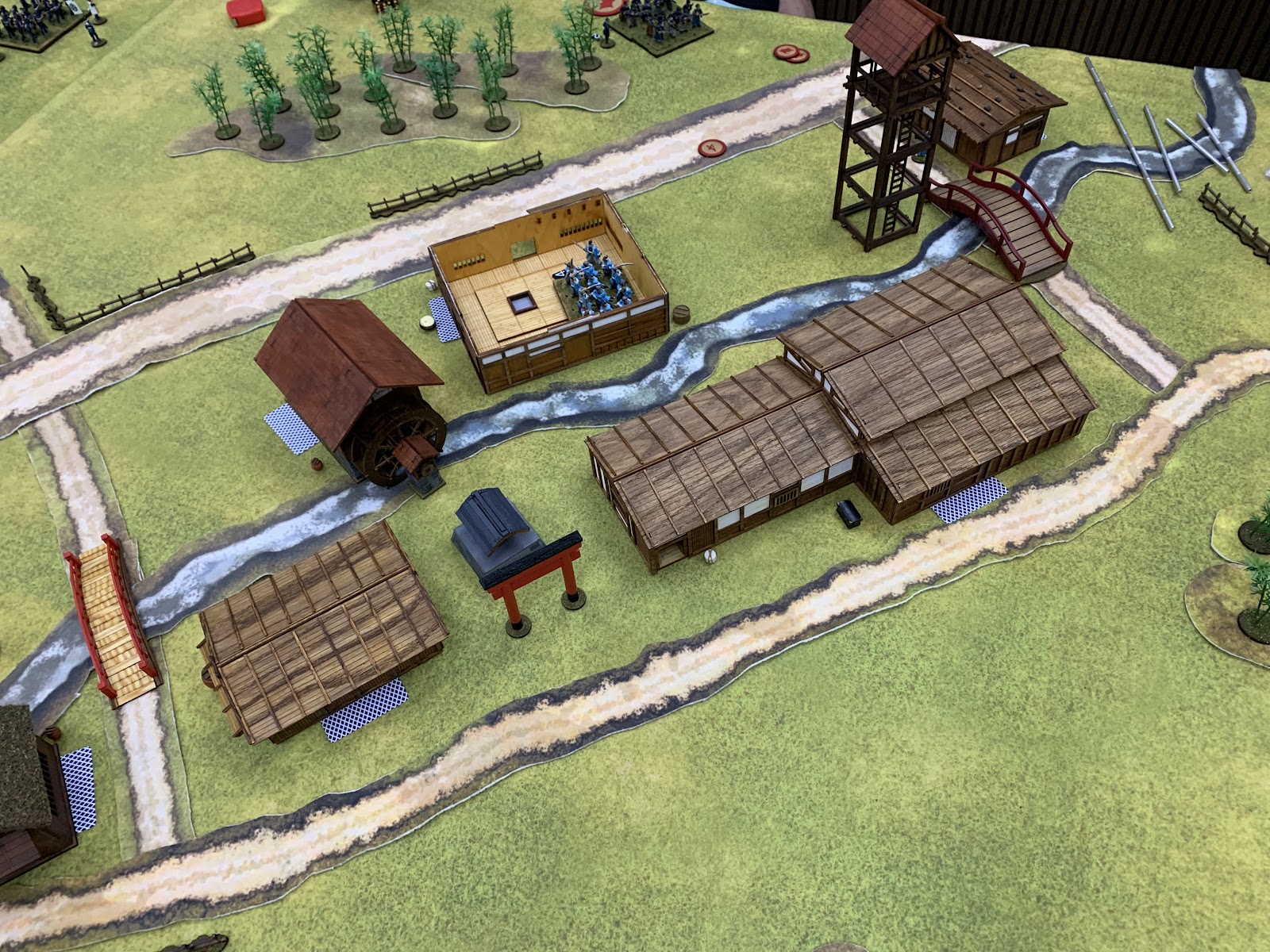 |
| Early moves: the Shinsengumi quickly occupied the inn, with no success. |
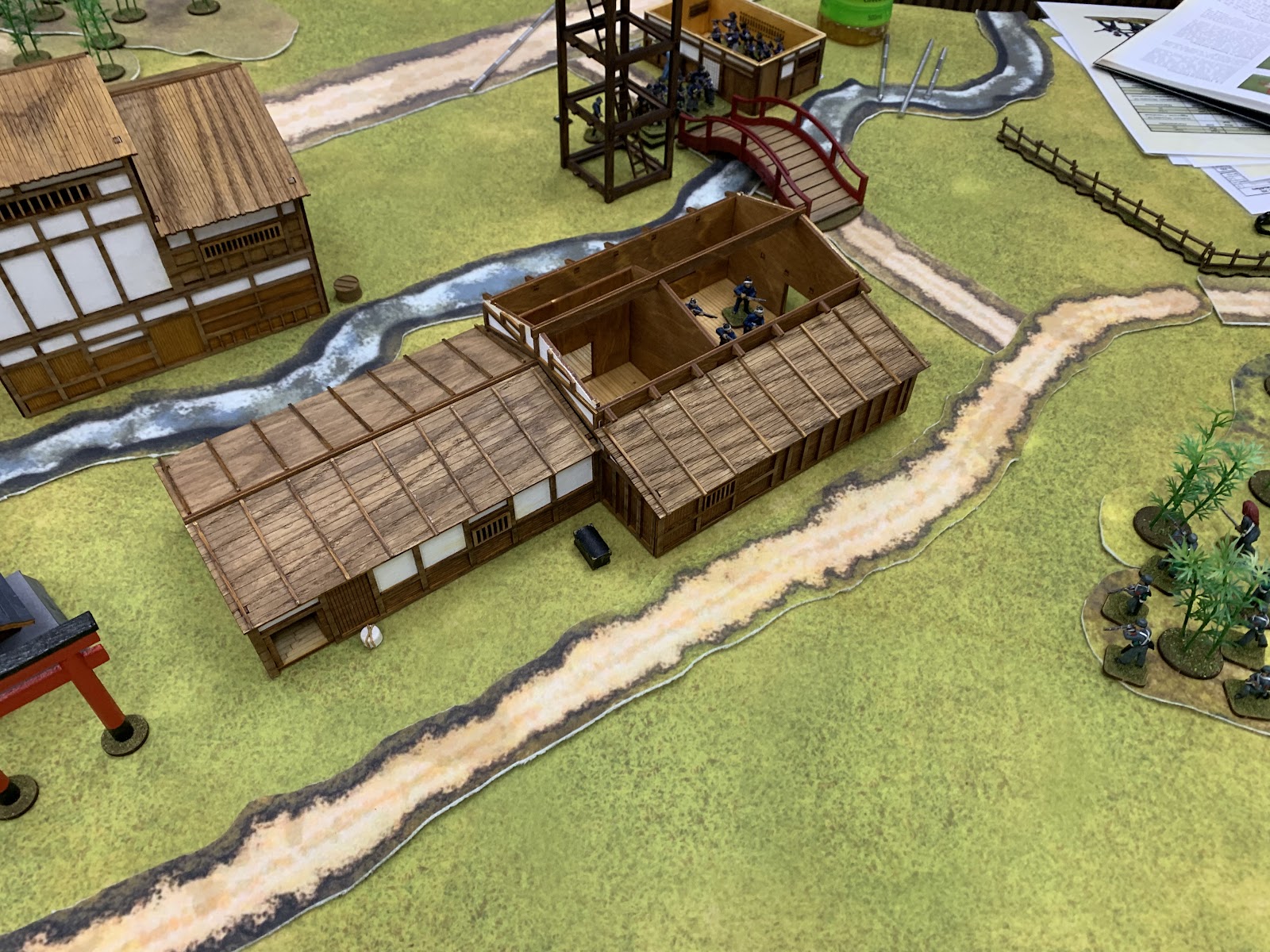 |
Shogunate skirmishers search the warehouse across the river and find nothing, while one of their musketeer units behind finds itself similarly out of luck next to the watchtower. Note the Imperial skirmishers creeping up on the right.
|
 |
| The Shinsengumi get lucky and find the spy in the watermill, but the pressure is now on as the main body of the imperial force (just out of frame) begins trading volleys with the Shogunate line. |
 |
| On the right, the Imperial skirmishers get a clean shot against an exposed Shogunate musketeer group and score some very good hits. |
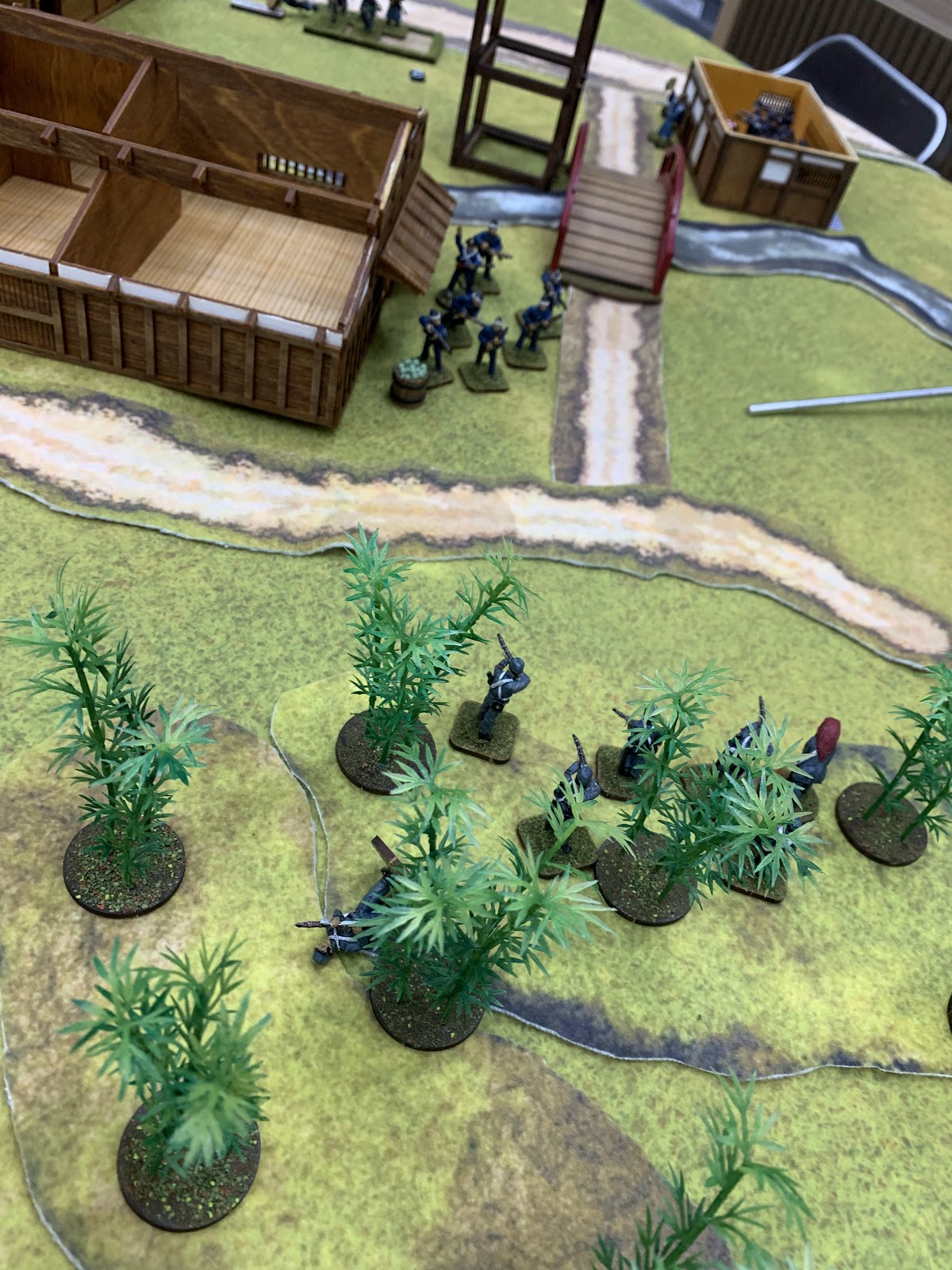 |
| The Shogunate skirmishers then file out of the warehouse and get a shot off against the Imperials, killing one. |
 |
| But the return fire from the Imperials proves devastating, killing five of the Shogunate skirmishers and wounding their Leader. Shogunate morale was becoming precipitously low. |
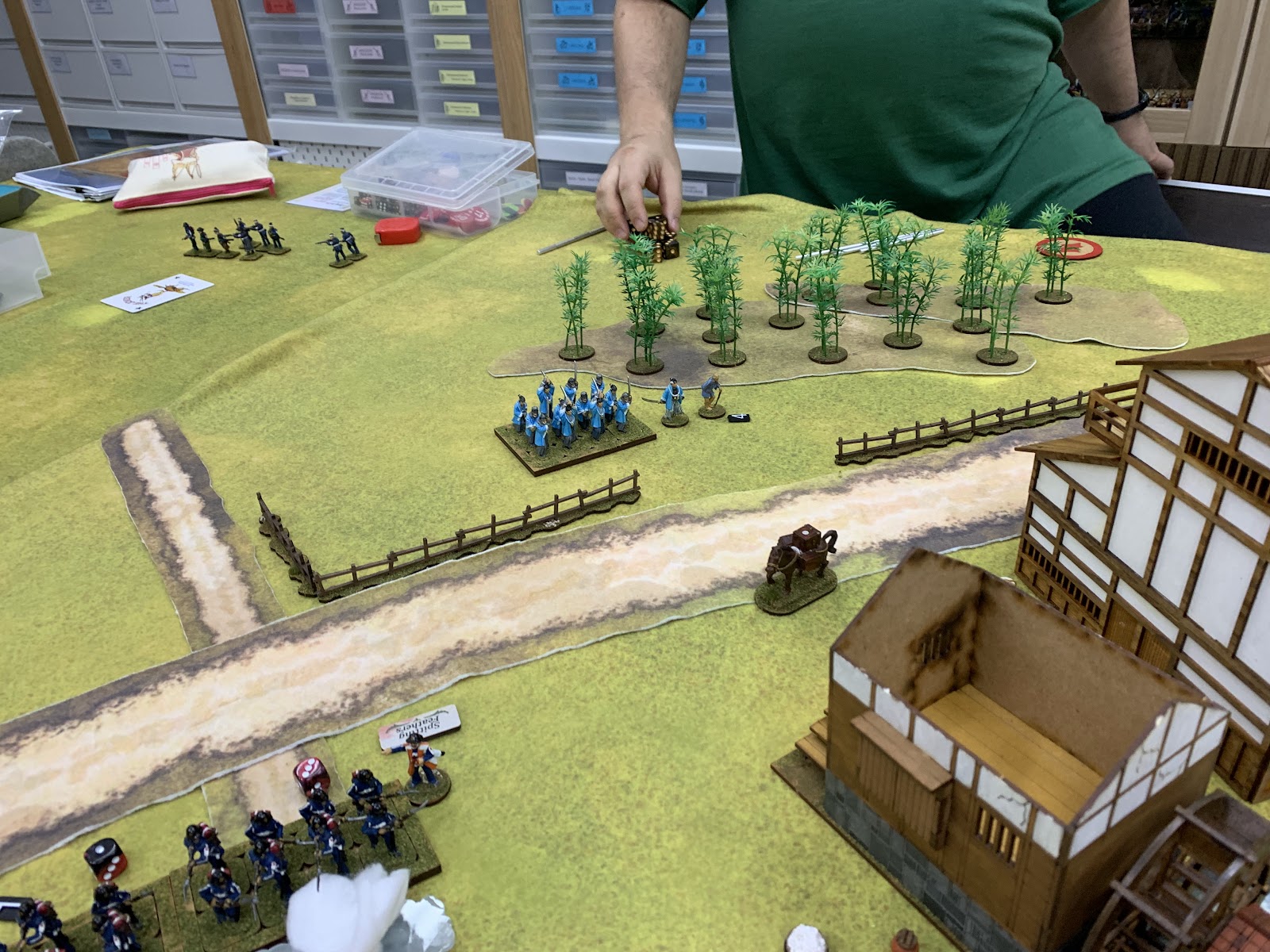 |
| Could the Shinsengumi make off with the spy before morale collapsed? |
 |
| Tragically, no. A final round of fire by the Imperial skirmishers broke the Shogunate army's resolve, and although the spy was technically under their control, they had fled the field in disgrace. |
After a convincing result on Friday, I kept the entire setup the same and replayed it with Gareth on Tuesday. As shall be seen, Gareth would move much more aggressively than James and Timmy had done, but would it pay off for him?
 |
| Shogunate riflemen in open column approach the bridge while the Shinsengumi prepare to ford across next to them. |
 |
| The riflemen surge further forwards, seeking cover in the woods before their Imperial counterparts can position themselves to oppose them. |
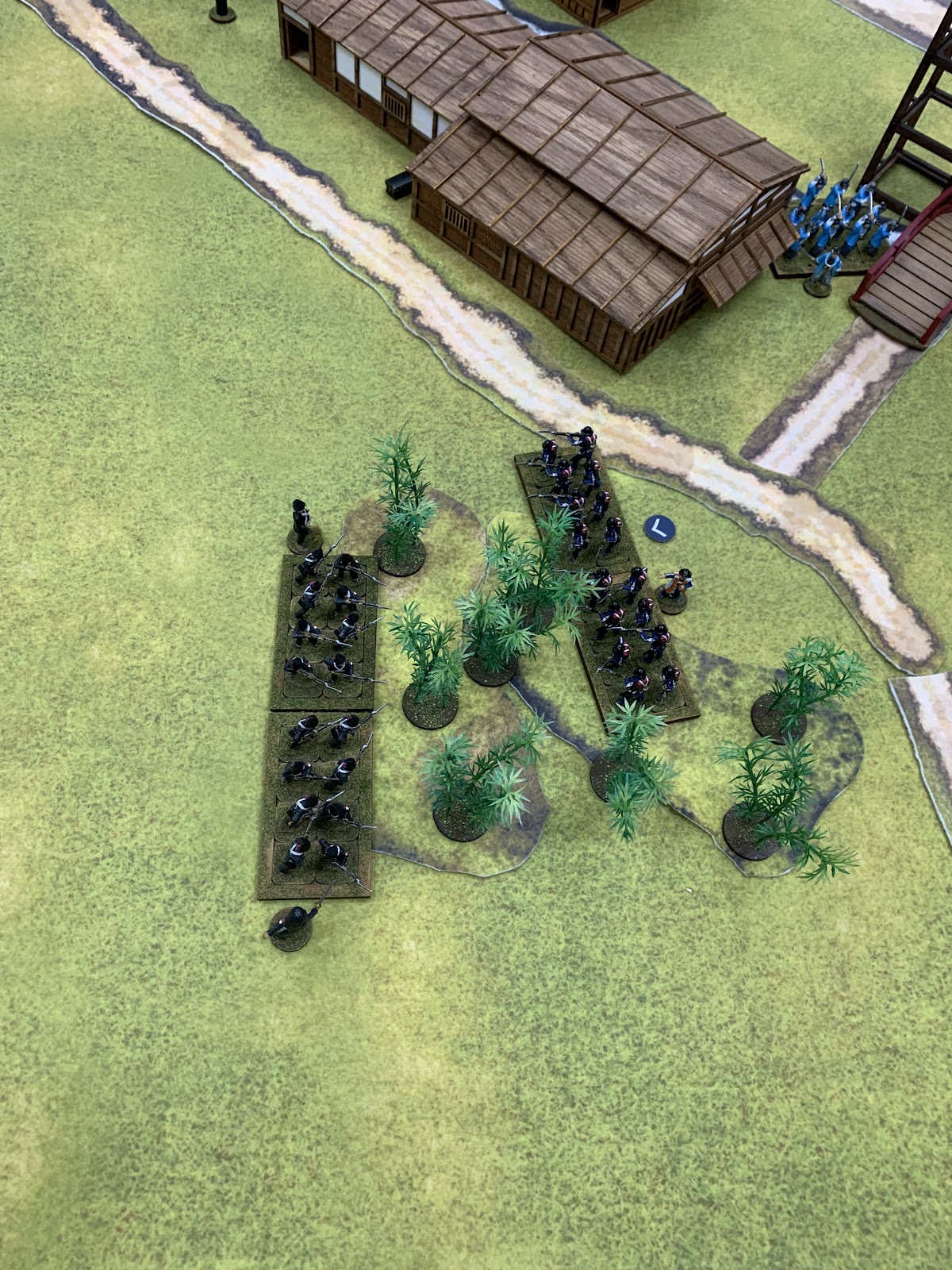 |
An interesting game of chicken. With visibility in the wood limited to 4", one side or another had to advance before firing, but doing so (without a command card bonus) would mean giving up the ability to aim before firing for a +1 modifier to hit. Who would go first?
|
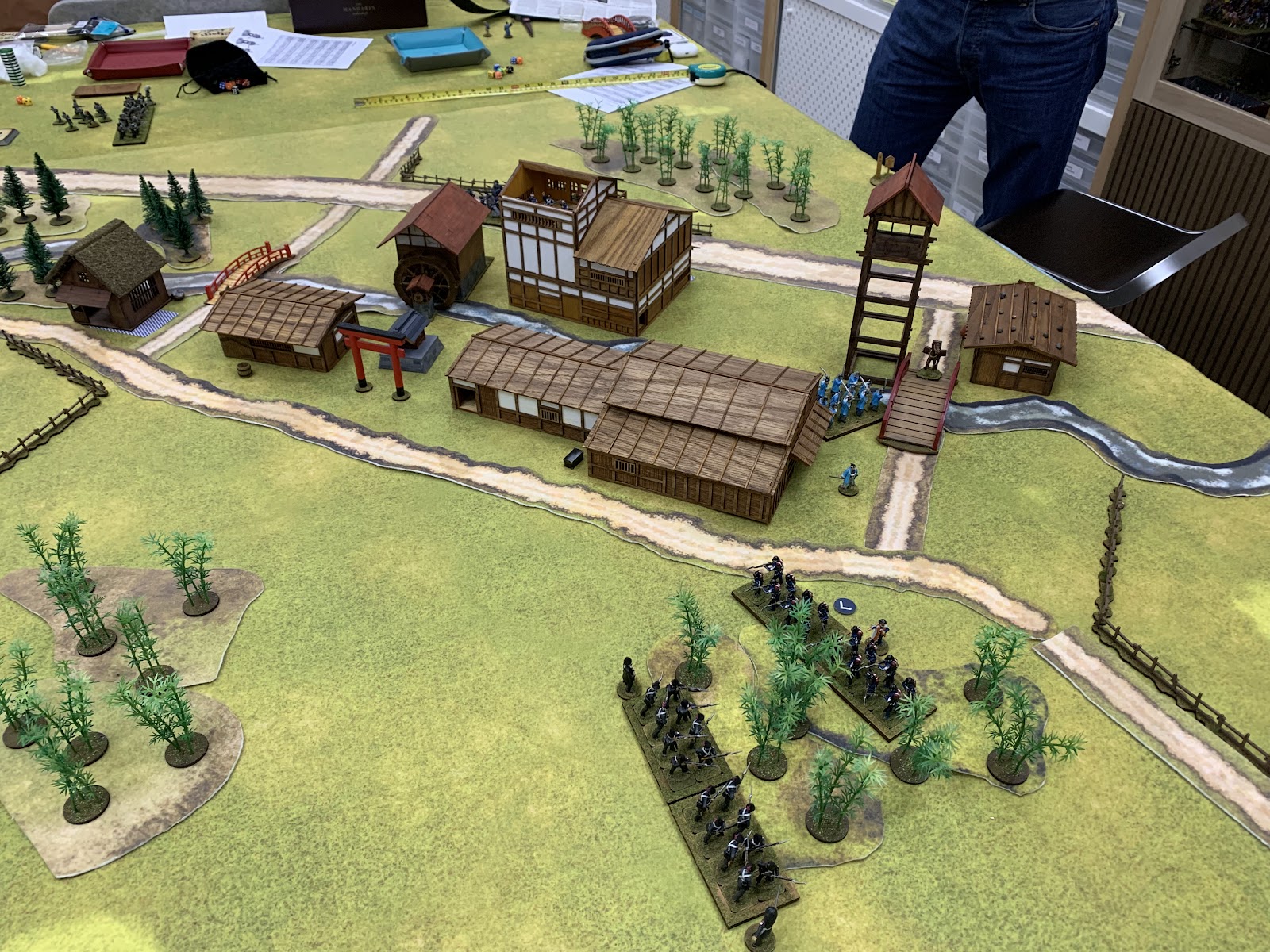 |
| Worse still, the Shogunate skirmishers had set themselves up on the upper storey of the inn, with a wide field of fire from the extended window. With the Imperials so far failing to deploy any of their other units, things seemed dire. |
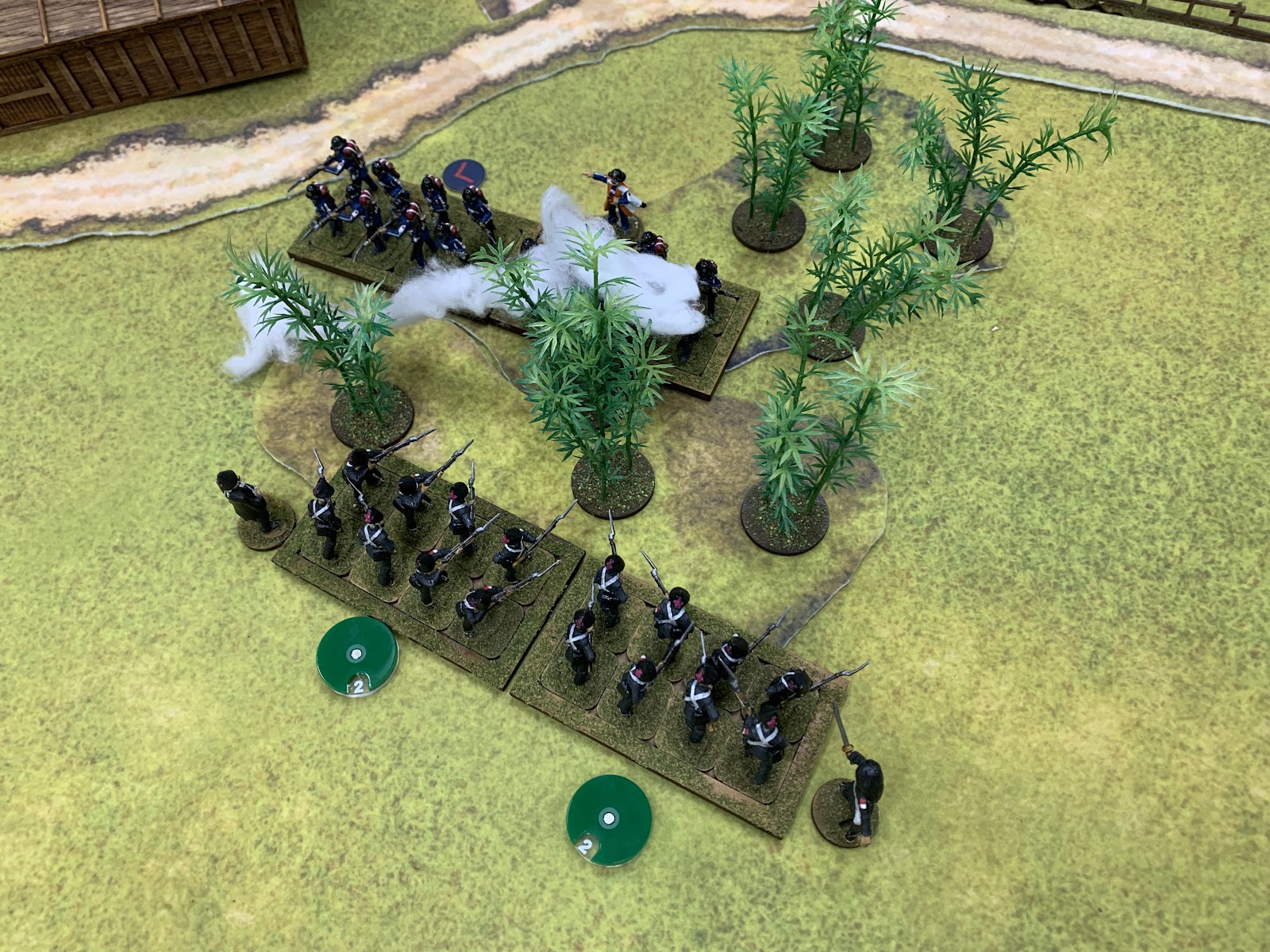 |
| For a moment, fortune seemed to smile upon me, as Gareth (who decided he would make the first move) inflicted only four points of Shock and no casualties from his first volley. |
 |
| But then, a Random Event struck, which saw the Shogunate riflemen, energised by their own fire, surge forwards 2D6" into melée contact, getting +2D6 per unit to boot! |
 |
| Remarkably, Gareth only won the melée by 2 hits, but that still meant I was down 9 men while he lost 7, and I had to withdraw and take additional Shock on top of the 4 inflicted in the combat. |
 |
| Worse still, those 9 casualties for me included both of my Leaders, substantially worsening my morale. Gareth's big man was injured as well, but remained in control of his faculties, while my own had passed out, leaving command to his NCO, himself too injured to issue orders without Command Cards. |
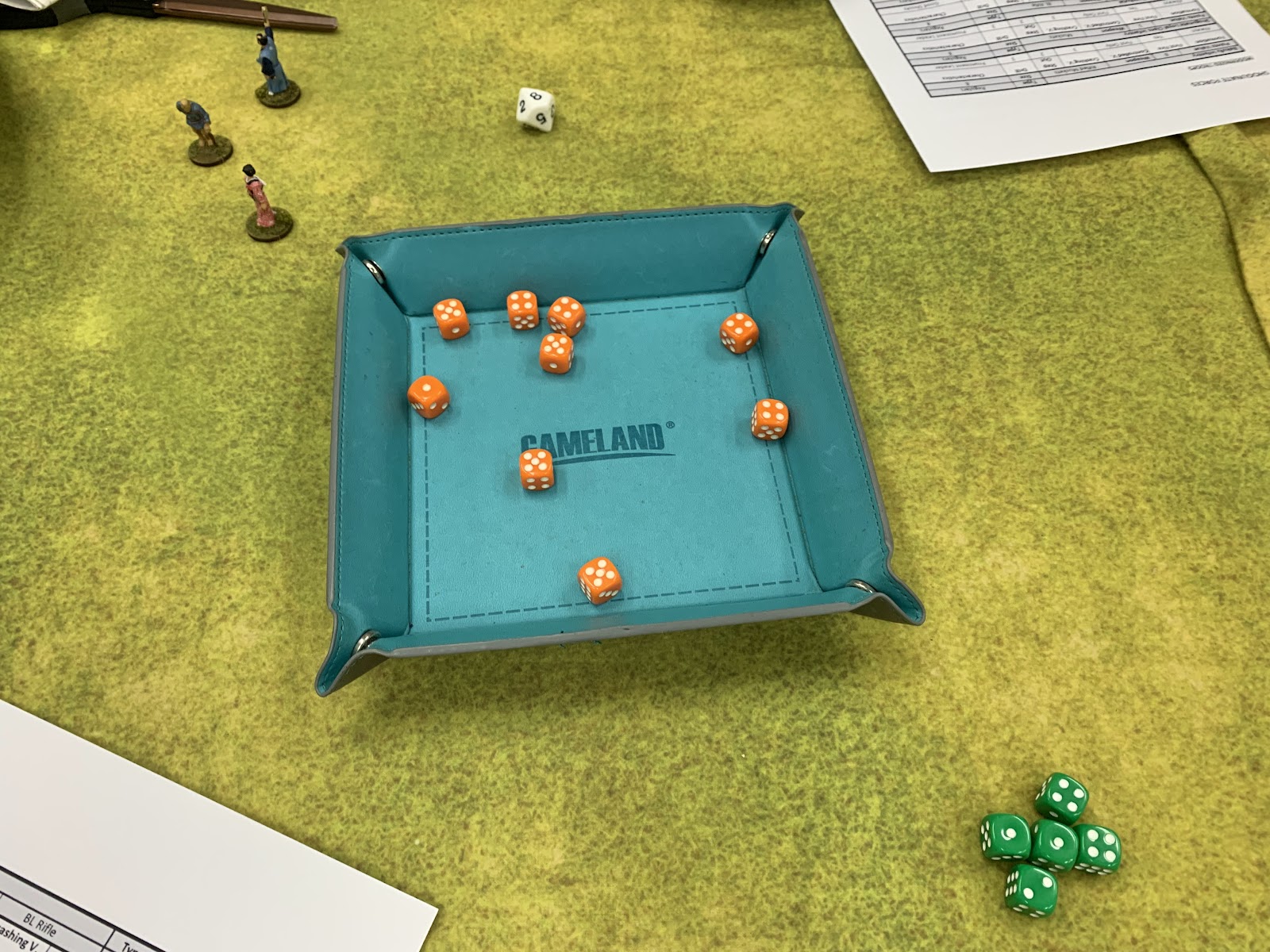 |
| Two successive rounds of pinpoint-accurate fire from Gareth's skirmishers saw off the rest of my line infantry. Was there anything else I could do? |
 |
In a stroke of luck, I was able to bring out my skirmishers on the flank of his riflemen, routing the already-weakened group on the left.
|
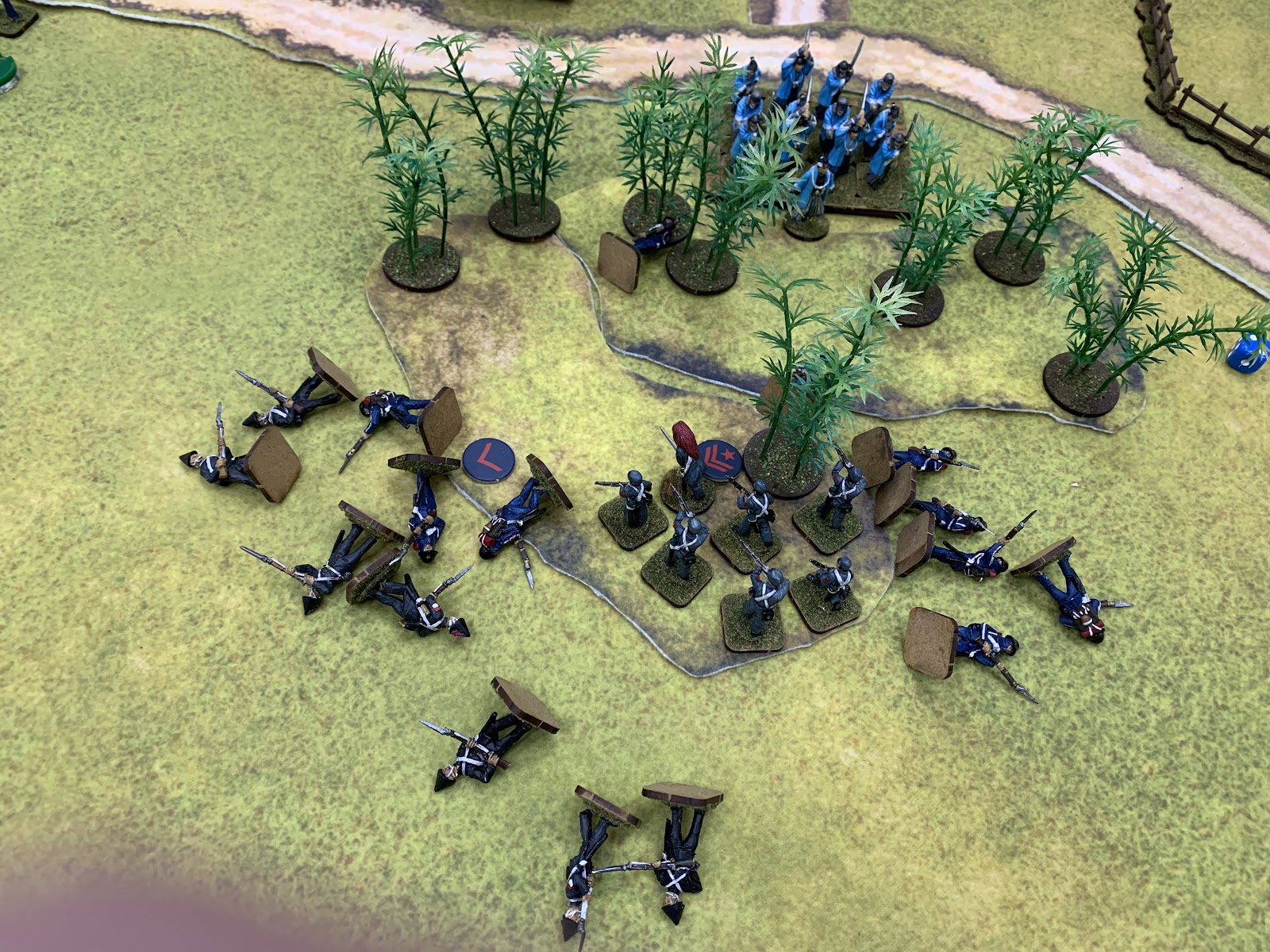 |
| Naturally, seeing what had worked for Gareth, I followed up with a valiant charge that drove off the other half of his riflemen, only for my Leader to be the sole casualty in the encounter, suffering a minor injury but still taking enough off my force morale to break my army's resolve. |
On the whole, an interesting pair of engagements. What's clear is that the amount of losses you need to take before collapse can be very low indeed, and that a concentrated push against a single vulnerable element can be enough to take it over the edge. Game 1 certainly had more of a swing to it thanks to the race for me to take down the Shogunate force morale before they achieved their objective, whereas I think my delayed deployment in Game 2 more or less precluded any chance of a decisive win. Gareth moving aggressively was a risky approach (especially as his musketeers hung back to search the houses), but my inability to bring out my full force in response, combined with the shortage of good cover on my side, and his skirmishers up in the attic of the inn, all tipped things in his favour. The skirmishers made a good effort, so I can claim a small moral victory there.
This was also a bit of an opportunity to show off some of the kits from TRE Games I've done up over the last couple of years, four of which (the warehouse, the inn, and the two shops with the wooden roofs) formed the centrepiece of the table. These have some quite interesting layouts to have to work around, especially given the limitations that Sharp Practice places on firing from windows and doorways.
After this foray down to the 1860s, it's back to the Sengoku for a while...






















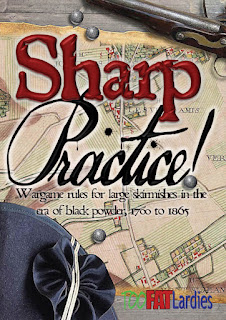

Nice games as usual!
ReplyDelete